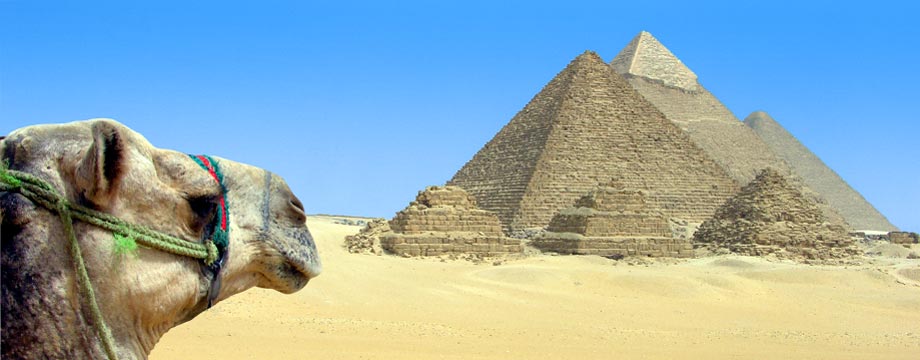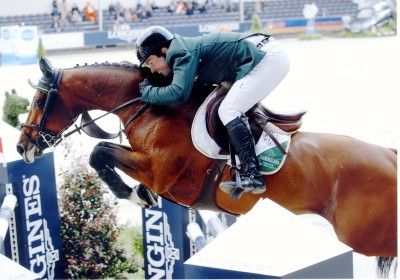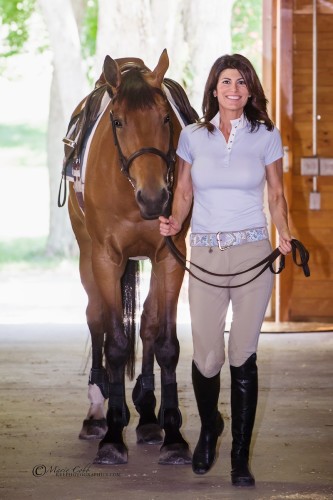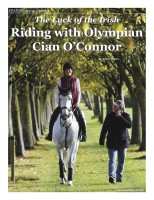 When I was in Wellington, Florida, during the winter of 2013, I ran into Cian O’Connor … actually, it was more like I saw him, made a beeline toward him and pounced! I quickly said, “Hi Cian, could you possibly spare a few minutes to share some advice and insights into your riding and training with a novice to the sport?”
When I was in Wellington, Florida, during the winter of 2013, I ran into Cian O’Connor … actually, it was more like I saw him, made a beeline toward him and pounced! I quickly said, “Hi Cian, could you possibly spare a few minutes to share some advice and insights into your riding and training with a novice to the sport?”
Without hesitation, he replied, “Sure. Catch up with me after my competition tomorrow afternoon. I’ll be at the International Arena.”
I did as told and met up with him the next day. At the end of my interview I asked, “Would you be able to help me with my riding?”
“I would be delighted,” he replied. Eighteen months later, I sent him an email. “Are you free this summer or fall to train me in Europe? “Yes,” he responded. “How’s October?”
Excited beyond belief, I booked my flight from Boston to Dublin. Visiting Ireland in and of itself was a dream come true for me, but the added benefit of training with a world-class rider, and Olympic medalist to boot, was bucket- list stuff.
After a few days filled with riding and training, Cian invited me over to meet his family at their beautiful home outside Dublin. When we had concluded a tour of his lovely property, I sat down with him to gain further insights from this Irish superstar.
Sidelines: We ended our last visit with you heading into the 2013 show summer season. How did that go?
Cian O’Connor: After selling Blue Loyd to Nikki Walker in the winter of 2012, I was short of a top horse. I was very fortunate that she and her family allowed me the opportunity to compete the horse on two occasions to help the Irish team in the Nations Cup series in both Switzerland and Ireland. Dublin is always a favorite show of mine and it was a career highlight to have won the feature class there in 2013, the Grand Prix. To win again on him a year after the Olympics was extremely special to me. And, as you can imagine, winning the Dublin Grand Prix is something every Irish rider wants to do, so it was fantastic.
Sidelines: Then, to top things off, you had a son.
CO: Yes, it’s been great with Ben — he’s loads of fun. Of course, we weren’t prepared for those sleepless nights! But the bond forged with your child is something special that isn’t possible to understand until you experience it.
Sidelines: What do you perceive as the differences between the American and European styles of riding?
CO: The Americans are very stylish, with their classical seat and long leg. Many come up through the equitation ranks and learn a very smooth way of riding. I think that, combined with those who have gone to Europe and learned how to vary their horse’s canter stride, create a more complete rider. The top American riders are as good, if not better, than any in the world.
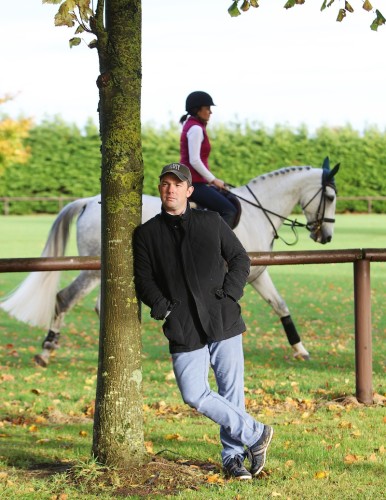
Cian relaxes for a moment while Victoria rides in the background
Photo by Laurence Dunne Jumpinaction.net
Sidelines: Do you think Americans have influenced the European style of riding?
CO: Yes, I think so, but I don’t think one system is right or wrong. The Americans ride a lot more forward to the jump, but if you only ride forward, then your horse gets too long and strung out. You have to be able to learn to ride in a good rhythm, but at the same time keep your horse together, such as Beezie Madden, Kent Farrington, Laura Kraut, McLain Ward and others — the good ones — are able to do.
Sidelines: What type of flat work do you do?
CO: We do dressage specifically for show jumping, as it’s very important to practice the same pace that you’re going to need to jump a track in the arena. We use lots of canter poles and cavalettis and teach them to go forward and back smoothly by varying the number of strides between them. Shoulder-in, leg yielding and other lateral movements are essential to help make the horse supple. We also incorporate many transitions, so that they respond to what you’re asking, and to keep the balance off their front end. The emphasis on flatwork is so critical because good or experienced horses can jump anything, but the two things that are really essential is that they listen to you, and when you want to win and go fast, you need them balanced at the gallop.
Sidelines: During training, while I was riding your horse, Anna, you suggested that I relax my hand and talk to her. This made a big difference in her manageability. Why is that so important?
CO: Yes, it’s always good to use your voice and the horse gets used to you, trusts you and then relaxes. I try to teach from the ground, so that the amateur can learn to work their horse for themselves. Sometimes we do need to hop on and realign them, but if the professionals are always the ones setting the horse up, then when it comes time to show, the rider is on their own, and that can be tricky. Also, it’s great to have a school horse, or lesson horse, to practice on. This is invaluable, as you don’t want to train your Grand Prix horse every day; you need to mind them. If a good young rider came to me, I would like to have plenty of horses to teach them on, for practice and to jump the big and wide fences, so as to not wear out their top mount.
Sidelines: Can you comment on how expensive it is to be in this sport?
CO: It is an expensive sport, and there are many who have had the good fortune to get backing. Then there are those riders who have come up on their own, such as the likes of Kent Farrington; he found horses and owners. Also, Irish rider Darragh Kenny; he originally won a bursary (monetary award) to train with Missy Clark in Florida, where he stayed on to make a business out of it. With strong work ethic and determination, he managed to put a team of horses under himself. In 2014 he jumped with the Irish team and is winning classes all over the world. I don’t want to give him a bigger head than he has if he reads this, but for me he is one of the best riders to come out of Ireland in a long time, and my point in emphasizing him is that he made it on his own, not with a sponsor or wealthy background. It’s nice to see that’s still possible today!
Sidelines: How do the shows in Florida compare to the European circuit?
CO: WEF is a great venue. There are all levels of competition and it’s a wonderful place to develop a horse. I primarily go to coach my client, Nikki Walker, and manage her operation there, which allows me to bring over several horses to sell or train up for the summer European circuit. It’s also very nice to be in Florida during the winter months, and to have my family there. Yet when that circuit’s over it’s nice to compete in Europe. It’s nice to have the best of both worlds.
Sidelines: What will it take to get to the Olympics in Rio in 2016?
CO: It’s going to be a tough task for the Irish team to qualify for Rio. Unfortunately, we missed the cut by one place at the World Championships in Normandy last year. The Irish lads jumped really well, but the team missed out by one fence. It would have been great to put that to bed, to have gotten the qualification and taken the pressure off, as now we really have to finish in the top three (of the non-qualified teams in the European championship) in Aachen, Germany. The challenge now is for those with capable horses to have the foresight to see the big picture and not get caught up chasing ranking points and individual classes. The Olympic Games are where it’s at and ultimately what everyone should aspire to, as that’s where the medals are.
Sidelines: Do you have a horse for Rio?
CO: I searched Europe up and down and must have tried over 100 horses since August [2014]. I was very fortunate to find Good Luck and am extremely grateful to Nikki’s family who purchased him for me with Rio in mind.
Sidelines: What are your thoughts about the team versus individual approach to the sport?
CO: When I started riding, Gerry Mullins was my coach. He was an Army rider and very team oriented. In recent years, Nations Cup jumping has probably been diluted a bit because of the emphasis on the Grand Prix, due to the size of prize money. You have to understand that if the winnings are high and you have a really good horse, you’re going to aim for the Grand Prix. But the way I look at it, there are a lot more spinoffs to the team approach. For example, if you’re on a winning team in Aachen, Dublin or Calgary, the TV and media coverage and all the publicity it brings can connect you to your next owner, client or sale. There are those who are looking to make their living with large purses; I am more interested in the business side of it — the buying and selling of horses. I have made team jumping my career, I suppose, probably more than anybody. Every year I plan my show schedule to the Nations Cup. I jumped my first in Croatia in 1999 and Dublin last year was my 96th Nations Cup.
Sidelines: Wow, that’s a lot of Nations Cups! What are your goals for 2015 and beyond?
CO: To develop and train hard to get myself and my horses in shape for the big international shows this summer.
Sidelines: Where do you keep the horses at WEF?
CO: The horses stay at Nikki Walker’s farm. I will be fairly busy, between my own riding and training, and coaching Nikki and my other client, Emily Short, but I think it will be a lot of fun. My two riders, Ross and Logan, will be there to compete, as well. We will bring some horses to further develop well-schooled, talented horses that will be good for the amateur market, as well as some younger Grand Prix prospects to compete.
Sidelines: What recommendations do you have for an amateur rider on how to find a good horse?
CO: You need to work with people who have a good reputation, who have found others good horses, and who will offer after-sales support. If anyone would like to send a query, we would be happy to help them find the perfect horse. They can go to my website to get in touch.
Sidelines: Cian, thank you so much for the wonderful week of training and riding at beautiful Karlswood Stables!
CO: My pleasure. Happy to have you!
For more information, visit cianoconnor.com.
Photos by Laurence Dunn Photography, unless noted otherwise

